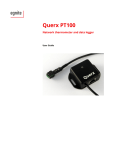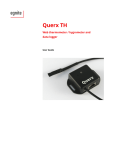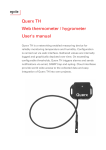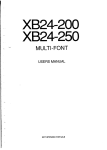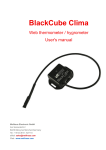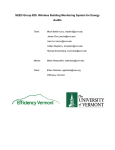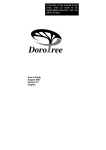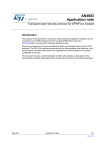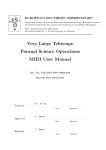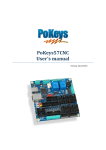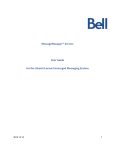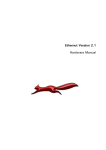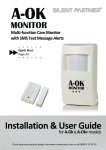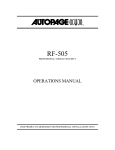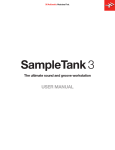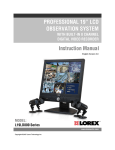Download Querx WLAN - preliminary manual
Transcript
Querx WLAN Wireless Thermometer / Hygrometer and Data Logger Querx WLAN TH Querx WLAN PT100 Querx WLAN PT1000 User manual PRELIMINARY Manual version: 0.97 Firmware version: 3.0 Date: 01.06.2015 Table of Contents 1 1 2 3 3 4 5 6 7 7 8 8 8 8 9 10 10 11 11 13 14 14 15 15 16 16 16 17 18 19 20 20 21 22 22 24 1 Introduction 1.1 1.2 1.3 Safety instructions Explanation of symbols About Querx WLAN Querx WLAN at a glance Features Possible fields of application Included in delivery Spare parts and accessories 2 Putting into operation 2.1 2.2 2.3 2.4 Preparation Mounting Network connection Connecting the probe Connecting a single wire Sensor connection and configuration Power supply Network configuration over DHCP Manual network configuration Installation of Device Discoverer Assign network configuration 2.5 2.6 2.7 3 Accessing the web interface 3.1 3.2 3.3 3.4 3.5 Host name Home page Log in Accessing the configuration back end Overview on the configuration back end 4 Basic configuration 4.1 General settings Select language System name, Contact and Location Configuration of the temperature probe Set date and time Configure data logger Disable Discovery function Reset internal memory Restart the device Network configuration Cable Ethernet interface Dynamic network configuration Static network configuration WLAN interface Dynamic network configuration Static network configuration 4.2 27 28 28 29 30 30 31 32 32 33 34 34 35 35 36 37 39 39 39 39 42 45 46 46 47 48 48 48 49 49 50 50 51 51 52 52 53 53 54 55 56 56 57 4.3 Select active network interface. User Management Add user Edit user Remove user Disable anonymous access Automatic log out 5 Configuration of Alerts 5.1 Alert basics Dead-band Alert delays Alert for heavy fluctuations Actions to be carried out on alerts Setting up alerts Temperature alerts Humidity alerts (Querx WLAN TH) Dew point alerts (Querx WLAN TH) 5.2 6 Configuration of Interfaces 6.1 Web interface Configuration of the web interface E-Mail interface Manage email accounts Manage email recipients Email templates Cloud services Data export to ThingSpeak Data export to Xively Modbus/TCP Activate Modbus/TCP SNMP General settings Activate SNMP Agent Activate SNMP traps Download MIB Syslog Configure syslog server 6.2 6.3 6.4 6.5 6.6 7 Data access 7.1 Web interface Currently measured values and alerts Last sensor events Data logger Visualisation of recorded readings Export recorded data via web interfaces Embed chart into other pages Data access over cloud providers Mobile Apps 7.2 7.3 7.4 57 57 57 59 59 59 60 60 60 61 61 62 62 63 63 64 66 67 67 68 69 69 70 70 7.5 HTTP interface Requesting current data Requesting recorded data 8 Maintenance, tips and troubleshooting 8.1 8.6 Restart Querx WLAN Warm reboot Cold reboot Configuration backup and restore Configuration backup Configuration restore Reset configuration Configuration reset via web interface Manual configuration reset Firmware-Updates Install firmware image Activate firmware image Activate alternative firmware image Battery change Opening the enclosing Changing the battery Troubleshooting 9 Appendix 9.1 9.2 9.3 Measuring and logging procedure Drilling template Specifications Querx WLAN TH Temperature sensor Humidity sensor Error of measurement after exposure to extreme circumstances Calculation of the dew point Querx WLAN PT100 / PT100 Conformity Calibration of sensors Modbus Registers SNMP Object Identifiers Export data format Technical support Notes on Storage Proper Disposal Manufacturer and Contact Disclaimer 8.2 8.3 8.4 8.5 72 73 74 74 75 76 76 76 77 77 78 79 9.4 9.5 9.6 9.7 9.8 9.9 9.10 9.11 9.12 9.13 1 Introduction Querx WLAN is a networking enabled measuring device for acquiring room climate or only temperature values, depending on the model. This manual covers configuration, operation and maintenance. Querx WLAN online resources Further information can be found on the websites http://www.egnite.de and http://sensors.egnite.de. 1.1 Safety instructions Please read this manual carefully and follow security instructions below to minimize the risk of injury and damage. Intended use Querx WLAN is used to acquire and process environmental parameters at a fixed place, and provide this data over several digital interfaces. Every other use of the device is regarded as not intended. The manufacturer can not be held responsible for consequences from unintended use. Risk for life by electric current To avoid accidents with electric current, please follow these instructions: Only use device, cable and power adapter in proper condition! Disconnect the device from the power supply before maintenance! Do not modify the device or its accessories! Let only qualified staff members repair the device! Do not immerse the device in water or other liquids! 1.2 Explanation of symbols Within this manual, following symbols are used: Introduction 1 ⚠ ⚠ ⚠ Danger This symbol indicates danger of injury Attention This symbol indicates a risk, that may lead to the damage of the device Information This symbol emphasizes useful hints and background information. 1.3 About Querx WLAN Querx WLAN acquires environmental parameters and provides them over network interfaces. The alert function sends notifications over email (TLS / StartTLS), SNMP trap and Syslog message if critical thresholds are exceeded. The internal memory can record at least 7.5 years of sensor data. The measurement results are displayed as interactive chart in the web interface. Alternatively, you can manually export the data in several formats or request them over a HTTP interface. Cloud connectivity brings Querx WLAN into the Internet of Things and allows world wide data access over web and app. SNMP connects Querx WLAN to network management solutions, using Modbus/TCP it is easy to employ the unit in industrial process management systems (SCADA). Furthermore, status, error and alert messages can be sent to a syslog server. Introduction 2 1.3.1 Querx WLAN at a glance (1) Push button (currently without function) (2) Status LED (3) Push button for configuration resets (4) WLAN antenna (5) Sensing cable (6) Micro-USB jack for power supply (7) Ethernet link LED (8) RJ 45 jack for Ethernet (9) LED for Network activity 1.3.2 Features Stand-alone device. No additional computer or software is needed Alert notifications over email, SNMP trap and syslog Data logger with a capacity of 4 million records = 7.5 years Data export as CSV, JSON and XML Manifold interfaces for accessing currently measured and recorded data Encrypted email communication (StartTLS / TLS) Cloud connectivity for world wide data access Introduction 3 Small dimensions 1.3.3 Possible fields of application Server room monitoring Pharmacies Hospitals Food hygiene Estate monitoring Automated climate profiles for buildings Preventive conservation in museums, archives and depots Cause determination for mold remediation. Introduction 4 1.3.4 Included in delivery Querx WLAN TH Set (Item EGN601015) Querx WLAN TH with temperature and humidity sensor WLAN antenna Ethernet cable MicroUSB cable USB power adapter with interchangeable clippings for UK, EU, USA and AU CD with software and documentation Querx WLAN TH (Item EGN601115) Querx WLAN TH with temperature and humidity sensor Querx WLAN PT100 Set (Item EGN601315) Querx WLAN PT100 with test sensor WLAN antenna Ethernet cable Micro USB cable USB power adapter with interchangeable clippings for UK, EU, USA and AU CD with software and documentation Querx WLAN PT100 (Item EGN601415) Querx WLAN PT100 with test sensor Querx WLAN PT1000 Set (Item EGN601615) Querx WLAN PT1000 with test sensor WLAN antenna Ethernet cable Micro USB cable Introduction 5 USB power adapter with interchangeable clippings for UK, EU, USA and AU CD with software and documentation Querx WLAN PT1000 (Item EGN60715) Querx WLAN PT1000 with test sensor 1.3.5 Spare parts and accessories Following accessories and spare parts can purchased from the manufacturer: Ethernet cable WLAN antenna MicroUSB cable USB power adapter with interchangable clippings for EU, UK, US and AU CD with software and documentation DakkS calibration certificate On http://shop.egnite.de you can find a selection of Pt100 and Pt1000 temperature probes, which can be used with Querx WLAN PT100 or Querx WLANPT1000. Introduction 6 2 Putting into operation 2.1 Preparation If the temperature of the device differs from the ambient temperature, please allow it to acclimate. Wait for two hours before you connect the unit to the power supply. ⚠ ⚠ Attention Temperature differences between device and its environment can cause condensation and damage the device. Information Temperature differences between humidity sensor and environment can cause measurement errors 2.2 Mounting Querx WLAN can be wall-mounted using the lashes of the enclosing. Alternatively, you can use cable stripes to attach the unit to tubes. Please pay attention to following instructions: Querx WLAN is suitable for indoor applications. Do not install the unit in places directly exposed to sunlight. Querx WLAN TH: Please ensure that the humidity probe is exposed to sufficient but not too strong air circulation. Measurements in stagnant air are possible, but can cause measurement errors. The unit can be installed in 3 dimensions: sensing cable points left sensing cable points right sensing cable points to the bottom Putting into operation 7 Please do not install Querx TH with the sensing cable pointing to the top. 2.3 Network connection 1. Using the provided Ethernet cable, connect Querx WLAN to a network or directly to the computer from which you want to configure the device. 2.4 Connecting the probe Querx WLAN PT100 / PT1000 supports any 2-, 3- and 4-wire Pt100 / Pt1000 probes. To connect a probe you will need: A tool with a fine tip, such as a watchmaker's screwdriver or tweezers A ballpoint pen Maybe a magnifying glass 2.4.1 Connecting a single wire 1. Push the button above the clip, into which you want to insert the wire with a ball-point pen. 2. Insert the wire. 3. Release the button. 4. Check if the clip has locked by gently pulling the wire. 5. To release a wire, press the button again and pull the wire out of the clip. 2.4.2 Sensor connection and configuration Above the clips for the sensor wires, you find two DIP switches, over which you configure the type of sensor you intend to use. 1. Look up the switch configuration for your particular probe in the following image. 2. Use a tool with a fine tip to set the switches the corresponding configuration. If needed, use the magnifying glass. Putting into operation 8 3. Insert the single wires into the clips according to the following image. 4-wire probe 3-wire probe ⚠ 2-wire probe Information Depending on the applied production standard, the color encoding for you sensor might differ from the examples in the image. In this case please consult the manufacturer's data sheet. 2.5 Power supply 1. Prepare the wall plug adapter by gently pushing the clipping for your country into the guide rails from above, until it locks in place. 2. Now connect the wall plug adapter to the device, using the provided micro USB cable. 3. Put the adapter into the wall outlet. Querx WLAN's status LED lights yellow. Putting into operation 9 ⚠ Danger Never use the device with a damages adapter. There is a risk for live caused by electrical current. If you do not have a free wall outlet, you can directly connect Querx WLAN to the free USB port of a computer. 2.6 Network configuration over DHCP Over DHCP, Querx WLAN can obtain an automatic network configuration. If valid settings are received, the status LED lights green. If a network error has occurred, Querx WLAN blinks yellow. In this case, check whether the network cable is connected properly. If the problems remain, ask your network administrator for advice. 2.7 Manual network configuration To manually configure Querx WLAN, you first need to establish a connection to the device. This initial connection is usually configured automatically and afterward you will be able to access its web interface following the instructions in chapter 3 Accessing the web interface. If your network does not support DHCP and the computer from which you want to configure the unit does not support mDNS (e.g. if you are using Windows XP), you have to set up the initial network configuration manually. ⚠ Putting into operation Information Most users don't need to perform the following steps. Please continue with chapter 3 Accessing the web interface. 10 2.7.1 Installation of Device Discoverer On the supplied CD-ROM you will find the application Device Discoverer, which allows remote configuration of Querx WLAN. 1. Start the installation software for Device Discoverer. 2. Follow the instructions of the installation wizard. 2.7.2 Assign network configuration 1. Start the application Device Discoverer. 2. Right-click on the device, which you want to configure, and choose Device configuration. 3. Enter an IP address and a network mask. 4. Click the OK button. Putting into operation 11 Querx WLAN will restart with the new configuration. The status LED lights yellow. As soon as the device is available, the status LED blinks green. Putting into operation 12 3 Accessing the web interface 3.1 Host name Access via host name With mDNS, you can directly access Querx WLAN over its system name in the local network. This name can be configured in the configuration back end. 1. Open a web browser and enter the following URL in the address bar: http://<systemname>.local/ Per default, this system name is querx00000, where you have to replace the six 0s with the last six characters of the device's MAC address. This address can be found on the sticker at the bottom side of the unit. For the example image above, the address is: http://querx000000.local./ ⚠ Information If you have changed the IP address of the device, you might need to clear the DNS cache of windows. To do so, enter the following into the input prompt: ipconfig /flushdns Accessing the web interface 13 Access over Bonjour From the Safari web browser, you can also access Querx WLAN over the Bonjour menu. ⚠ Information If you cannot access the web interface, you need to manually set a network configuration. How to do this is discussed in chapter 2.7 Manual network configuration. 3.2 Home page On Querx WLANS's homepage, you will find the recorded data in an interactive chart. In the chapters 7 Data access and 6 Configuration of Interfaces you will learn how to use display and export functions. In the upper part of the homepage, you find some buttons to log in at Querx WLAN and to open the configuration back end. 3.3 Log in If you have configured users and assigned them access rights, you need to log in at Querx WLAN. 1. Enter your user name in the field User, your password in the field Password. 2. Click on Login. Accessing the web interface 14 In Querx WLANS's default configuration, no users are configured. You can learn more on user management in chapter 4.3 User Management. 3.4 Accessing the configuration back end 1. To access the configuration back end, click on the Configuration button in the upper right corner of the homepage. 3.5 Overview on the configuration back end You now see the configuration back end. 1. Configuration menu Here you can navigate to configuration options. 2. Settings In this section, you change the configuration. 3. Online help On the right side of the screen, you find short explanations for the several configuration options. Accessing the web interface 15 4 Basic configuration 4.1 General settings For proper operation, the following configuration steps need to be performed. 4.1.1 Select language In the configuration back end, open the page Interfaces / Web. 1. In the section Web interface, select the language for the web interface. 2. Click on Save to apply your changes. 4.1.2 System name, Contact and Location On the start page of the configuration back end, which can also be accessed over the System / General menu item, you can provide some general information.. The system name is used to identify the unit in alert notifications and over M2M interfaces. Also, this name is part of the host name, over which you can access the web interface (see chapter 3 Accessing the web interface). The other parameters are needed for SNMP. For the configuration of SNMP, refer to chapter 6.5 SNMP. Basic configuration 16 1. Enter a System name. 2. If you want to use SNMP, enter a responsible member of staff in Contact person and the location of the device in System location. 3. Click on Save to apply your changes. 4.1.3 Configuration of the temperature probe In the configuration back end, click on Sensors / Temperature. 1. Choose the physical temperature unit for Querx WLAN to work with from the field Unit. 2. Querx WLAN PT From Sensor type, choose the number of wires over which your probe is connected to the device. 3. Querx WLAN PT Set the field Filter to the utility frequency, which is used in your county. For use in Europe, set it to 50 Hz Filter. Basic configuration 17 4. Click on Save to apply your changes. 4.1.4 Set date and time We recommend to automatically obtain date and time using an NTP server. If Querx WLAN is not connected to the internet and within your local network no NTP server is available, you can also set the values manually. In the configuration back end, click on System / Time. Set time zone 1. Select the appropriate time zone for your country from Set time zone. 2. Set daylight saving time options: A. If in your country daylight saving time is applied and time changeover happens at the last Sundays in March and October, check Auto DST. B. If DST is applied in your country, but time changeover does not happen at the last Sundays in March and October, do not set Auto DST. Set DST manually when DST is in effect. 3. Click on Save to apply your changes. Automatically obtain date and time Querx WLAN can automatically obtain date and time over the Net Time Protocol, if an NTP server is available. 1. Enter the IP address or the host name of an NTP server at Set NTP, for example pool.ntp.org. 2. Click Sync NTP to receive date and time over network. Basic configuration 18 ⚠ Information As long as a valid NTP server is available, Querx WLAN will automatically update date and time once an hour. If you cannot receive date and time over network, you need to manually provide these values or obtain them from the Set date and time manually computer from which you configure the device A. Set time manually 1. In the section Set time enter the current date in the little endian date format in the field Date. For the February 1st, 2014 this is 01.02.2014. Then, enter the current time in the field Time, with hours, minutes and seconds separated by colons. For half past 1 pm, this is 13:30:00. 2. Click on Save to apply your changes. B. Obtain date and time from the configuration computer 1. Click on Sync PC. Do not click on Save afterward. 4.1.5 Configure data logger Querx WLAN is equipped with a data logger, which once a minute records following data: Maximum values for temperature and humidity Minimum values for temperature and humidity Average values for temperature and humidity. Querx WLAN has a capacity of 4M records. This equates to a period of 7.5 at least years. Values are only recorded, if since the last record, values have changed. Therefore the actual storage period might significantly longer. The storage is organized as circular queue. If the capacity is exceeded, the oldest entries are overwritten first. Basic configuration 19 4.1.6 Disable Discovery function To allow manual network configuration with Device Discoverer, Querx WLAN allows writing access on the configuration with Querx Discoverer per default. After you have initially configured the unit, you should disable this service to increase security. Open the Page System / Network. 1. Untick the check box Discovery. 2. Click on Save to apply to save you changes. Information ⚠ After having disabled the discovery service, Querx WLAN is not shown in the Device Discoverer any more. 4.1.7 Reset internal memory As soon, as you put Querx WLAN into operation, the device starts to record its measurements. To restart recording with the new configuration, you can delete the data collected so far. In the configuration back end, open the page Maintenance / Reset. 1. Click on the button Delete sensor data. Basic configuration 20 1. Confirm the data reset by ticking the check box 'Are you sure?' 2. Afterward click on Yes. Please stay patient, as the operation can take some time. Afterward, the device is restarted and the unit begins the new recording. 4.1.8 Restart the device If you have changed the network settings and the device was not restarted during the basic configuration, please perform a warm start, as discussed in chapter 8.1 Restart Querx WLAN. Basic configuration 21 4.2 Network configuration Querx WLAN can by connected to a network either over the cable based Ethernet interface or over the WLAN interface. Please keep in mind, that the unit supports only one active network interface at time. To enable the cable Ethernet interface, just plug in a network cable. As soon, as the interface detects a network link, the WLAN interface is disabled. If you remove the cable from the jack, the WLAN interface is enabled again. 4.2.1 Cable Ethernet interface Per default, Querx WLAN obtains a network configuration automatically. Nevertheless, you can assign a static IP configuration. This makes the boot process faster and the device can be addressed over the same IP address at any time. ⚠ 4.2.1.1 Information After changes to the network configuration you need to reboot the device. This is discussed in chapter 8.1 Restart Querx WLAN. Dynamic network configuration If you want to enable dynamic network configuration via DHCP, please open the Page System / Network in the configuration back end. Basic configuration 22 1. Choose Obtain IP address automatically. 2. Configure a DNS server: A. If you want to obtain your DNS settings automatically as well, choose Obtain DNS Server automatically. Please keep in mind that this work only if a DHCP server is available in your network. B. If you want configure own DNS servers, choose Set DNS server manually and enter the IP addresses in the fields Primary DNS server and Alternative DNS server. 3. Click on Save to apply your changes. 4.2.1.2 Static network configuration To set up a static network configuration, open the page System / Network. Basic configuration 23 1. Choose Set IP address manually. 2. Enter an IP address for the device. 3. Enter a Network mask. 4. Enter the IP address of the router, which connects the network to the Internet, at Standard gateway. 5. Choose Set DNS server manually. 6. Enter the IP addresses of the nameserver at Primary DNS server and Alternative DNS server. 7. Click on Save, to apply your changes. Afterward restart the device as discussed in 8.1 Restart Querx WLAN. 4.2.2 WLAN interface To configure the WLAN interface, open the page System / WLAN in the configuration back end. Basic configuration 24 1. Click on Scan to update the list of available net- works. 2. Choose the network from the list, or if it is hidden, enter the SSID into the field SSID. 3. Choose the encryption method for the network from Encryption. ⚠ 4.2.2.1 4. Enter the Shared Key for your network 5. Click on Save to apply your changes. Information You need to restart the device after you change the network configuration. This is discussed in chapter 8.1 Restart Querx WLAN. Dynamic network configuration If you want to enable danyamic network configuration via DHCP, please open the Page System / Network in the configuration back end. Basic configuration 25 1. Choose Obtain IP address automatically. 2. Configure a DNS server: A. If you want to obtain your DNS settings automatically as well, choose Obtain DNS Server automatically. Please keep in mind that this work only if a DHCP server is available in your network. B. If you want configure own DNS servers, choose Set DNS server manually and enter the IP addresses in the fields Primary DNS server and Alternative DNS server. 3. Click on Save to apply your changes. 4.2.2.2 Static network configuration To set up a static network configuration, open the page System / Network. Basic configuration 26 1. Choose Set IP address manually. 2. Enter an IP address for the device. 3. Enter a Network mask. 4. Enter the IP address of the router, which connects the network to the Internet, at Standard gateway. 5. Choose Set DNS server manually. 6. Enter the IP addresses of the nameserver at Primary DNS server and Alternative DNS server. 7. Click on Save, so apply your changes. Afterward restart the device as discussed in chapter 8.1 Restart Querx WLAN. 4.2.3 Select active network interface. The active network interface is selected automatically, depending on the link status of the cable Ethernet interface. If a network link is detected, the cable Ethernet interface is enabled. If no link is detected, the wireless interface is enabled. Changing the active interface makes the device reboot and can therefore take some time. Basic configuration 27 The active network interface is indicated by the status LED as long, as not alert is in effect: green active cable Ethernet connection blue active WLAN interface 4.3 User Management Querx WLAN can be accessed as anonymous user, who needs no authentication. You can configure up to three additional users and disable the anonymous access. You can assign access right groups to the system users: Disabled: User has no access to the device. Read data: User can read measured data. Read data / read config: User can read measured data and device configuration. Read data / write config: User has unrestricted access to measurement data and to the device configuration. 4.3.1 Add user To add a user, open the page System / Users. 1. In the section Users click on the Add button next to a free line. Basic configuration 28 2. On the following page enter a User name and a Password in the according fields. 3. Choose access right Group for the user 4. Click on Save to apply your changes. 4.3.2 Edit user Open the page System / Users in the configuration back end. 1. In the section Users, click on the Edit button. 2. Do your changes. 3. Click on Save to apply your changes. ⚠ Basic configuration Information It is only possible to remove write access from a user, as long, as at least one other user exists, who is able to write the configuration. 29 4.3.3 Remove user In the configuration back end, open the page System / User. 1. Click on the Delete button next to the user you want to remove. 2. Confirm the removal by clicking Yes on the following page. ⚠ Information You can only remove users with write access to the configuration, as long, as at least one other user exists, who is able to write the configuration. 4.3.4 Disable anonymous access As soon, as you have added a user who has write access on the configuration, you can disable or restrict anonymous access. Open the page System / Users in the configuration back end. Basic configuration 30 1. In the section Users click on the Edit button next to the Anonymous user. 2. Do completely disable anonymous access, choose Disabled from Group. If you only want to restrict anonymous access, choose the according group. 3. Click on Save to apply your changes. 4.3.5 Automatic log out If a logged in user shows no activity for a certain period, he will be automatically logged out. To configure this period, open the page System / Users in the configuration back end. 1. In the section Session enter the number of seconds, after which a user should be logged out automatically in the field Session timeout. If you want to disable automatic log outs, enter 0. 2. Click on Save to apply your changes. Basic configuration 31 5 Configuration of Alerts If critical environmental conditions occur, Querx WLAN can trigger alerts , over which the unit can inform via email, SNMP trap and syslog message. 5.1 Alert basics Querx WLAN supports following types of alerts: Upper temperature limit exceeded Lower temperature limit undergone Temperature rising too fast Temperature falling too fast. The model Querx WLAN TH additionally supports following types of alerts: Upper humidity limit exceeded Lower humidity limit undergone Humidity rising too fast Humidity dropping too fast Upper dew-point limit exceeded Lower dew-point limit exceeded ⚠ Information Alerts are triggered, if measured values exceed a limit, not if they reach it. 5.1.1 Dead-band To avoid repetitive alert notifications, you can set up a deadband for alerts, which are based on exceeding thresholds. This value determines, in how far the measured values have to move back in the direction of the normal state before another alert is triggered on again exceeding the threshold. Configuration of Alerts 32 In this example, a lower temperature limit of 15°C is set, Dead-band is 5. If a measured value under-runs the lower limit (1), an alert is triggered. If the value rises and again falls below the lower limit, no further alert goes off (2). The device needs to measure at least 20°C (3), before a new alert can be triggered (4). 5.1.2 Alert delays If short-term fluctuations in measurements should be accepted, e. g. temperature drops during ventilation, it is possible to configure an alert delay. This value determines how long a threshold needs do be exceeded steadily, before the according alert is triggered. In this example, delay is set to 2 minutes. The value is exceeded at 1:30 minutes (1). Nevertheless, the unit only triggers an alert at 3:30 (2). Please keep in mind, that the dead-band is applied here as well. The sensor needs to measure less than 25°C to prevent the alert from going off. Configuration of Alerts 33 5.1.3 Alert for heavy fluctuations For temperature and humidity, it is possible to configure alerts based on the difference between measured minimum and maximum values within a certain period. These alerts stay active, as long as the unit can detect the maximum difference over that period. It is possible to configure different alerts for rising and dropping temperatures. This example shows a temperature drop, after a window was opened. Drop value is set to 5°C, Drop time is set to 30 minutes. At 0.20 (1) the probe measures a temperature of 30°C. At 0.50 a window is openedand the temperature drops to 20°C immediately. Short time after, the unit detects a tempereature difference of more than 5°C within the last 30 minutes and triggers an alert (2) . At around 1:30 (4) the maximum difference is smaller than 5°C over the last 30 minutes and the alert is disabled (3). 5.1.4 Actions to be carried out on alerts Querx WLAN can cope with triggered alerts in several ways. This is discussed in detail in chapter 6 Configuration of Interfaces. Configuration of Alerts 34 5.2 Setting up alerts 5.2.1 Temperature alerts To configure temperature alerts, open the page Sensors / Temperature in the configuration back end. Alert for exceeding thresholds 1. If you want to accept short-term fluctuations, enter the amount of seconds by which an alert should be postponed in Alert delay. 2. At Lower Limit enter the temperature which has to be under-run to raise an alert for temperature too low. 3. At Upper Limit enter the temperature which has to be exceeded to raise an alert for temperature too high. 4. Enter a value for Dead-band, e. g. 2. 5. Click on Save to apply your changes. Alerts for temperatures dropping or falling to fast Alerts for falling and rising temperature need two values each: The maximum temperature difference and the time in which this difference should not occur. Configuration of Alerts 35 1. First enter the maximum temperature difference for falling temperature at Drop value. 2. Now enter the number of seconds, in which this difference should not occur at Drop time. 1. Enter the maximum temperature difference for rising temperature at Rise value. 2. Now enter the number of seconds, in which this difference should not occur at Rise time. 5.2.2 Humidity alerts (Querx WLAN TH) To set up humidity alerts, open the page Sensors / Humidity. Alert for exceeding thresholds 1. If you want to accept short-term fluctuations, enter the amount of seconds by which an alert should be postponed in Alert delay. 2. At Lower Limit enter the value which has to be under-run to raise an alert for temperature too low. 3. At Upper Limit enter the value which has to be exceeded to raise an alert for humidity oo high. 4. Enter a value for Dead-band, e. g. 2. 5. Click on Save to apply your changes. Configuration of Alerts 36 Alerts for rising or dropping humidity values Alerts for falling and rising humidity values need two values each: The maximum temperature difference and the time in which this difference should not occur. 1. First enter the maximum difference for falling value at Drop value. 2. Now enter the number of seconds, in which this difference should not occur at Drop time. 3. Enter the maximum difference for rising values at Rise value. 4. Now enter the number of seconds, in which this difference should not occur at Rise time. 5.2.3 Dew point alerts (Querx WLAN TH) Alerts for exceeding thresholds Configuration of Alerts Dew-point alerts can be set up on the page Sensors / Dew Point 37 Alert for exceeding thresholds 1. If you want to accept short-term fluctuations, enter the amount of seconds by which an alert should be postponed in Alert delay. 2. At Lower Limit enter the dew-point which has to be underrun to raise an alert for Dew-point too low. 3. At Upper Limit enter the dew-point which has to be exceeded to raise an alert for Dew-Point too high. 4. Enter a value for Dead-band, e. g. 2. 1. Click on Save to apply your changes. Configuration of Alerts 38 6 Configuration of Interfaces Querx WLAN provides several interfaces to request currently measured and recorded values and to inform on occurring alerts. 6.1 Web interface 6.1.1 Configuration of the web interface In the configuration back end, open the page Interfaces / Web. 1. In the section Web interface, select the period of time from Refresh rate, after which the dynamic information on the web pages, such as temperature, time or used memory, should be updated. 2. In the section Chart, choose the color for the temperature graph from Temperature color. 3. Querx WLAN TH: In the section Chart, choose the color for the humidity graph from Humidity color. 4. Click on Save to apply your changes. 6.2 E-Mail interface Querx WLAN sends email notifications to up to 4 recipients over up to 2 email servers. 6.2.1 Manage email accounts To enable sending emails, you need to provide at least one email account. You optionally can add a second email account as fall-back. Configuration of Interfaces 39 In the configuration back end, open the page Interfaces / Email. 1. In the section Email accounts, click on the action Add next to one of the free slots. 2. On the next page, enter the sender's email address in the field Sender. 3. Enter the host name or IP address of the mail server in SMTP server. 4. Specify the SMTP port for your mail server at Port. 5. If you need to authenticate at your mail server, activate the check box Authentication. 6. Enter a User name and a Password in the appropriate fields. ⚠ Information The log in data is written to the device without encryption. So do not use an email account over which intimate communication is carried out. If needed, create an own account for Querx WLAN. 7. Click on the Test button to check your settings. If everything is fine, the button turns green. If you have made a Configuration of Interfaces 40 mistake, the corresponding field will get highlighted. Correct the error and click on Test again. 8. Click on Save to apply your changes. Edit email account In the configuration back end, open the page Interfaces / Email. 1. In the section Email accounts, click on Edit next to the account, that you want to change. 2. On the following page, make your changes. 3. Click on the Test button to check your settings. If everything is fine, the button will turn green. If you have made a mistake, the corresponding field will be highlighted with a red border. Change the fields and click on Test again. 4. Click on Save to apply your changes. Configuration of Interfaces 41 Remove email account 1. In the configuration back end, open the page Interfaces / Email. 1. In the section Email accounts click on the action Delete next to the account you want to remove. 2. Confirm the removal by clicking Yes on the following page. 6.2.2 Manage email recipients Querx WLAN supports up to 4 email recipients, each of whom you can assign the mail server over which emails are sent. Also, you can choose the events on which notifications are sent for each recipients. In the configuration back end open the page Interfaces / Email. 1. In the section Recipients, click on the action Add next to one of the free slots. Configuration of Interfaces 42 1. On the next page enter the email address for the recipient in the field Email. 2. Choose the account over which you want emails to be sent to this address. Check the second account if you want to use it as a fall-back. 3. At Notify on, choose the events for which you want to send notifications to this recipient. 4. Click on Test, to check the settings. Check your email afterward. 5. Click on Save to apply your changes. Edit email recipient In the configuration back end, open the page Interfaces / Email. 1. In the section Recipients, click on the action Edit next to the recipient you want to change. Configuration of Interfaces 43 2. On the next page, make your changes. 3. Click on Test, to check the new settings. 4. Click on Save to apply your changes. Delete email recipient In the configuration back end, open the page Interfaces / Email. 1. In the section Recipients click on the action Delete next to the recipient, which you want to remove. 2. Confirm the removal by clicking on Yes on the next page. Configuration of Interfaces 44 6.2.3 Email templates Querx WLAN sends notifications when alerts occur or when the unit returns to the normal state. For both cases, you can define templates. In the configuration back end, open the page Interfaces / Email. 1. In the section Alert notifications, enter a Subject and an Message for alerts going off. 2. In the section Back to normal notification enter a Subject and a Message to be sent when the device returns to the normal state. You can use following variables, that are dynamically substituted on sending out the notifications: Configuration of Interfaces $S Name of the sensor that has triggered the alert $V Measured value $U Physical unit of the measured value 45 $I IP address of the device $L Location of the device $N Host name of the device $C Responsible member of staff 3. Click on Save to apply you changes. 6.3 Cloud services Querx WLAN can export the measured data to the Internetof-Things clouds Xively and ThingSpeak. This allows world wide data access and easy integration into own projects. Cloud services are updated every full 10 minutes. 6.3.1 Data export to ThingSpeak For the data export to ThingSpeak, you need to set up a ThinkSpeak channel. This can be done free of charge at the cloud provider's website: www.thingspeak.com To set up a cloud connection you will need the following data: The channel ID of your think speak channel The field ID for temperature values The write API key In the configuration back end, open the page Interfaces / Cloud. Configuration of Interfaces 46 1. In the section ThingSpeak, enter your write API key in the field API key. 2. Enter your Channel number in the field Channel number. 3. Enter the ID for the temperature field in Temperature Field ID. 4. Click on Save to apply your changes. After saving your ThingSpeak configuration, you find a Link below. If you click on that link, your ThinkSpeak channel will be opened in a new browser window. 6.3.2 Data export to Xively To connect Querx WLAN to Xively, you will need a Xively feed. You can set this up at the cloud provider's website: www.xively.com. You will need the following data to connect Querx WLAN to Xively. The ID of the Xively feed for Querx WLAN to update The API key that allows Querx WLAN to write on that feed In the configuration back end, open the page Interfaces / Cloud. 1. In the section Xively, provide the API key for write access. 2. Enter the Feed ID for your Xively feed. 3. Click on Save, to apply your changes. After saving the configuration, you will find a Link below. If you click on that link, your Xively feed will be opened in a new browser window. Configuration of Interfaces 47 6.4 Modbus/TCP Querx WLAN can send data via Modbus/TCP, for example if you want to employ the device in industrial applications (SCADA). You can find a listing of all addressable registers in chapter 9.6 Modbus Registers. Hands-on examples on how to use Querx and Modbus/TCP can be found on the product page at http://sensors.egnite.de. 6.4.1 Activate Modbus/TCP In the configuration back end, open the page Interfaces / Modbus. 1. Tick the check box Enable to activate Modbus/TCP. 2. If you want to allow configuration changes via Modbus/TCP, uncheck the check box Write Protection. 3. Click on Save to apply your changes. 6.5 SNMP The Simple Network Management Protocol SNMP allows to integrate Querx WLAN into network management systems, such as Nagios, OpenNMS or Zabbix. You can find the important SNMP OIDs in chapter The MIB can directly be downloaded from the device. Some hands-on examples on how to use Querx WLAN with SNMP, can be found on the product's website at http://sensors.egnite.de. Importand SNMP OIDs can be found in chapter 9.7 SNMP Object Identifiers. Configuration of Interfaces 48 6.5.1 General settings In the configuration back end, open the page System / General. 1. Enter a System name to identify the device over SNMP. Please keep in mind, that this name is also the host name for Querx WLAN, trough which it can be connected in the network. 2. In the field Contact provide a responsible member of staff. 3. Enter a System location for Querx WLAN. 4. Click on Save to apply your changes. 6.5.2 Activate SNMP Agent In the configuration back end, open the page Interfaces / SNMP. 1. In the section SNMP agent, tick the check box Enable, to active the SNMP agent. 2. Check the Read community and adjust it, if needed. 3. Click on Save to apply your changes. Configuration of Interfaces 49 6.5.3 Activate SNMP traps In the configuration back end, open the page Interfaces / SNMP. 1. In the section SNMP traps, provide the host that will receive traps sent by Querx WLAN at Trap destination. 2. Check the Trap Community and adjust it, if needed. 3. Select the events on which a SNMP trap should be send at Send trap on. 4. Click on Save to apply your changes. 6.5.4 Download MIB In the configuration back end, open the page Interfaces / SNMP. 1. In the section SNMP agent, click on Download next to MIB. Configuration of Interfaces 50 6.6 Syslog Querx WLAN can send a multitude of logging, error and alert messages though syslog. If problems occur, this functionality helps you to spot their origin. Software to receive syslog messages can be downloaded from the Internet. 6.6.1 Configure syslog server In the configuration back end, open the page System / Network. 1. Provide the IP address or the host name of your syslog server at Syslog server. 2. Click on Save to apply your changes. Configuration of Interfaces 51 7 Data access 7.1 Web interface 7.1.1 Currently measured values and alerts In the upper right corner of the homepage, you can see currently measured values and active alerts. On the image above, you can see: 1. An alert (↥) for Temperature being too high 2. at a value of 22,2 °C 3. An alert for Humidity being too low (↧) 4. at a humidity level of 52 % RH If there is an active alert, the on of the following alert symbols is shown, blinking red: Alert Data access Symbol Lower limit under-run ↧ Upper limit exceeded ↥ Value drops too fast ↓ Value rises too fast ↑ Sensor failure ✖ 52 7.1.2 Last sensor events In the configuration back end, you can review the last 16 sensor events, such as alerts, returns to normal states or sensor failures. You find the last sensor events on the page Maintenance / Events. 7.2 Data logger Every, Querx WLAN records maximum, minimum and average values for the last 60 seconds. With a capacity of 4,000,000 records, it is thus possible to aquire data for 7.5 years. On power failures, the sensor doe's not record new records. Data acquired so far is stored persistently and will not be lost. As soon as the power returns, Querx WLAN continues with the recording. Data access 53 7.2.1 Visualisation of recorded readings The chart on the home page show the development of temperature and, if you use Querx WLAN TH, humidity from the beginning of the recording. Full-color lines (1) show average average values, the brigther areas (2) surrounding this line show the minimum and maximum values. The horizontal bars show the thresholds, on which alerts are raised. Their width shows the dead band (3). Set displayed period 1. Choose the period which you want to display. Possible periods are year, month or week. 2. No choose the start date for this period. Data access 54 Adjust displayed peridod The gray bar below the chart is the time line of the selected period. With the two sliders to the left and the right, you can adjust the shown period. The emphasized area between the sliders can be moved to change the start date of the shown period. Change start time of period 7.2.2 Export recorded data via web interfaces You can export the recorded data over the web interface. Querx WLAN supports the data formats CSV and XML1. Open the Querx WLAN's web interface and set period and start date as discussed in the last section. 1 Over the HTTP interface, you can also request the data as JSON. Data access 55 1. Click on Export. 2. Choose an export data format from Format. 3. At Steps, set the time between to records in the export file. 4. Click on Download. One record contains the date and start time, as well as measured average, minimum and maximum values that have occurred in the period you have set at steps. 7.2.3 Embed chart into other pages Within your local network it is possible to embed the chart from the home page in other web pages using an Iframe. Open the Querx WLAN's home page. 1. Click on Iframe. 2. Copy the shown HTML source code into the clip board. Paste the HTML code into the source of the page, into which you want to embed the chart. 7.3 Data access over cloud providers If you have set up cloud services, you can access the transmitted data over the according web site or using the application programming interfaces, provided by the cloud service. To log in into ThingSpeak, use the following URL https://thingspeak.com/login. The developer's documentation can be found on https://thingspeak.com/docs. To log in into ThingSpeak, use the following URL https://personal.xively.com/ einloggen. The developer's documentation can be found on https://personal.xively.com/dev/. Data access 56 7.4 Mobile Apps For Android and iOS are apps available to access the sensor data from your mobile device. On https://play.google.com/store you can find the app Querx Discoverer, using which you not only can access the sensor data over LAN and cloud, but also configure the device using the discovery service. The Canadian company Codenize provides the app IoT monitor, with which you can access access cloud data over iPhone. 7.5 HTTP interface Querx WLAN allows to request currently measured and recorded data over HTTP. This makes it easy to set up own monitoring solutions. 7.5.1 Requesting current data Over the address http://<IP>/tpl/document.cgi?tpl/j/live.tpl&msub=<FORMAT> you have access to current measurement. The parameter msub specified the format, in which data is returned. Possible formats include XML, CSV and JSON. You can find example applications in the tutorial section on sensors.egnite.de. 7.5.2 Requesting recorded data Over the address http://<IP>/tpl/document.cgi?tpl/j/<FORMAT>.tpl you can access the data logger over HTTP. Following POST parameters are available: start Start time as Unix time-stamp end End time as Unix time-stamp step Resolution in seconds fname Returned file name Data can be returned as XML, CSV and JSON. Data access 57 Following example returns values from April 1st 2015 0.00 to April 2nd 2015 0.00 with 1 minute between two records. http://192.168.192.100/tpl/j/document.cgi? tpl/j/xml.tpl&start=1427846400&end=1427932800&step=60 You can find example applications in the tutorial section on http://sensors.egnite.de. Data access 58 8 Maintenance, tips and troubleshooting 8.1 Restart Querx WLAN There are two ways to restart Querx WLAN. 8.1.1 Warm reboot After some configuration changes, a reboot of the system is required. In the configuration back end, open the page Maintenance / Reset. 1. Click on the button System reset. 2. Confirm reboot by clicking Yes on the next page. 8.1.2 Cold reboot If the device does not react any more, you can perform a cold reboot. 1. Disconnect the device from the power supply. 2. Wait for about 20 seconds. 3. Reconnect the device to the power supply. Maintenance, tips and troubleshooting 59 8.2 Configuration backup and restore To backup your configuration or to reproduce a configuration on several devices, you can export the configuration and save it away. Following settings are ignored: Manual network settings Email accounts and passwords API keys for cloud providers 8.2.1 Configuration backup In the configuration back end, open the page Maintenance / Backup. 1. In the section Configuration backup click on Download next to Configuration. 2. Save the file by clicking on OK. 8.2.2 Configuration restore In the configuration back end, open the page Maintenance / Backup. Maintenance, tips and troubleshooting 60 1. In the section Configuration restore click on Choose File next to Upload. 2. Choose the configuration backup that you want to restore. 3. Click on Upload. 4. Restart Querx WLAN, see chapter 8.1 Restart Querx WLAN 5. Finally: Set up clouds, email accounts and users. ⚠ Information Please notice, that after a configuration restore a reboot is needed. 8.3 Reset configuration There are two ways to restore the factory defaults on the device. 8.3.1 Configuration reset via web interface Configuration resets carried our via Web interface will not reset the host name and the IP configuration. In the configuration back end, open the page Maintenance / Reset. 1. Click on Configuration reset. Maintenance, tips and troubleshooting 61 2. Confirm the reset by clicking on Yes on the following page. 8.3.2 Manual configuration reset In case you cannot log in to Querx WLAN, for example if you have lost the log in data, you can do a manual reset to restore the factory default. For that you will need: A ballpoint pen ⚠ Attention Do not use a pencil for a manual reset, as its lead could break and damage the device. 1. With the device turned on, press the reset button using the ballpoint pen. This button is just underneath the opening next to the status LED. The status LED blinks red . 2. Hold the button until the blinking stops. Querx WLAN is now rebooted with the factory defaults. Manual hardware resets will also reset the device's host name and IP configuration to the factory defaults. 8.4 Firmware-Updates To extend the functionality of Querx WLAN, egnite occasionally provides new firmware images. If needed, they can be installed on the device and afterward be activated. There are two slots to hold firmware images. If you activate one of those images, they are transferred into the internal memory and will be booted when the device is restarted. Maintenance, tips and troubleshooting 62 8.4.1 Install firmware image In the configuration back end, open the page Maintenance / Firmware. In the section Version you can see the currently running firmware version. If this version is lower than the version that you can find on http://sensors.egnite.de, a firmware update can be sensible. Install firmware Download the most recent firmware image from the http://sensors.egnite.de. Afterward, open In the configuration back end, open the page Maintenance / Firmware. 1. Select the Buffer, in which you want to install the new firmware image in the section Upload. This should be the buffer with the lowest firmware version number or an empty buffer. 2. Click on Choose file and select the downloaded firmware image. 3. Afterward click on Upload to write the image into the selected buffer. 8.4.2 Activate firmware image After you have uploaded a new firmware version, you need to activate it. In the configuration back end, open the page Maintenance / Firmware. Maintenance, tips and troubleshooting 63 1. In the section Activation choose the Buffer with the firmware image, which you want to activate. 2. Click on the button Activate to write the firmware image into the internal memory. Afterward the device will reboot with the new firmware. ⚠ Attention Do not disconnect the device from the voltage supply while transferring the firmware into the internal memory. This could damage the device 8.4.3 Activate alternative firmware image If, after changing the active firmware, unexpected problems occur, you can manually activate the other firmware image on the device. To do that you will need: A ballpoint pen ⚠ Attention Do not use a pencil for a manual reset, as its lead could break and damage the device. 1. Disconnect the device from the power supply. 2. Press the reset button using the ballpoint pen. You find the button underneath the opening next to the status LED. 3. Hold the button while you reconnect Querx WLAN to the power supply. The device starts blinking. After a couple of seconds the blinking stops and status LED lights red. 4. Now release the button. The alternate firmware image is written into the internal memory and Querx WLAN reboots. Maintenance, tips and troubleshooting 64 ⚠ Attention After the activation, please wait until the device has rebooted, before you disconnect it from the power supply. If disconnected during the transfer process, the device could be damaged. Maintenance, tips and troubleshooting 65 8.5 Battery change To enable the internal clock to operate without voltage supply, Querx TH is equipped with a battery. If its charge has reached a critical level, you will see a notification in the lower left corner of the web interface. Battery changes can be done on own risk, but we recommend to send the device in for maintenance. ⚠ Information Querx TH is operational without battery. In operation and under usual environmental conditions (temperature at about 23°C), you will not have to change the battery. If you disconnect the unit from the voltage supply, for example for storing, you need change the battery once every 5 years. To change the battery you need Two Phillips screw drivers, size PH0 and PH1 A battery, type: Renata CR1225 ⚠ Attention Please avoid getting in touch with any contacts when changing the battery. The device could suffer from damages caused by electrostatic discharge. Maintenance, tips and troubleshooting 66 8.5.1 Opening the enclosing 1. Loosen both screws at the bottom side of the unit, marked red in the image above. 2. Inside the device is another screw that you need to loosen. This is also marked red in the image above. 8.5.2 Changing the battery 1. Carefully lift the board at the side opposing the sensor cable. 2. Use the screw driver to push the old battery out of its socket from behind. 3. Insert the new battery into the socket. If needed, gently push it with the screw driver. 4. Place the board back into the enclosing. 5. Tighten the screw inside of the enclosing, as well as both screws at the bottom side of device. Maintenance, tips and troubleshooting 67 8.6 Troubleshooting Problem Action to take Chapter No network connection Perform a manual network configuration. 2.7 Check if there are problems with your network. Maybe ask your network administrator Querx WLAN reacts very slow In the configuration back end, open the page. Maintenance / Firmware If the value for Memory usage is bigger than 70%, close some browser windows showing Querx WLAN's web interface. Querx WLAN show strange measuring values Check if the sensor cable is connected properly. Log in data unknown Reset system configuration. 8.3 Unknown network configuration Perform a manual network configuration 2.7 Or: Reset the system configuration 8.3 NTP / Email / Cloud do not work Check if you have provided a valid DNS server. Reboot system afterward. 2.7 II need to log in every couple of seconds Increase the value for a Session timeout. 4.3 After a firmware update Querx WLAN doesn't work as expected If there is another firmware image available on the system, reactivate it. 8.4.3 If you have questions which are not discussed in this manual, please don't hesitate to get in touch with the manufacturer egnite. You can find the contact information at the end of this manual. We also suggest to have a look at the tutorial section on http://sensors.egnite.de. Maintenance, tips and troubleshooting 68 9 Appendix 9.1 Measuring and logging procedure Once a second, Querx WLAN performs a measurement. This live measurement data can be requested via SNMP, Modbus and the HTTP interface. Every minute, the data logger records maximum, minimum and average values since the last record, together with date and time. 9.2 Drilling template Appendix 69 9.3 Specifications 9.3.1 Querx WLAN TH Specifications Measuring range temperature -40 °C to 85 °C -40 °F to 185 °F Accuracy temperature ±0.4 °C from -10 °C to 85 °C / ±1.0 °C from -40 °C to -10 °C ±0.7 °F from 14 °F to 185 °F / ±1.8 °F from -40 °F to 14 °F Resolution temperature 0.1 °C / 0.2 °F Long term stability ≤ 0,01 °C / Jahr Messbereich Feuchte 0 % bis 95 % rF Accuracy humidity ±2% rH from 0 % bis 80 % RH at 30 °C (86 °F) ±4% rH from 80 % to 95 % RH at 30 °C (86 °F) Resolution humidity 1 % rFH Long-term stability humidity ≤ 0,25 / year Humidity sensor CMOS IC with polymide film Calibration By factory, DakkS callibration certificates available Sensor heating Integrated Ethernet 10/100 Mbit RJ45, HP Auto-MDIX Static or dynamic (DHCP client) IP WLAN 2.4 GHz IEEE 802.11b/g/n WLAN security WEP, WPA, WPA2 System Nut/OS 5 Firmware updates Over web interface, rescue function Data logger capacity At least 7.5 years internal (4,000,000 records) Protocals HTTP, SMTP, DHCP, SNTP, Syslog, SNMP, Modbus/TCP Nut/Discovery, XML, JSON and CSV over HTTP Web interface Password protection, chart, Live Update, HTML5, CSS3, JSON and SVG, User Management (3 Users / 3 Groups) Email Up to 4 receipients over to SNMP accounts SNMP SNMPv1 Agent and Traps Status LED RGB Date / time Battery backed real-time clock with SNTP update Power supply 5 V DC ... 5,5 V DC Consumption Typical 200 mA 1 W / Max. 300 mA 1,5 W Environment Operating conditions 40 °C to 85 °C, max. 95 %rH -40 °F to 185 °F, max. 95 %rH Storage conditions -40 °C to 85 °C, max. 95 %rH -40 °F to 185 °F, max. 95 %rH Mechanical data Housing material Housing color ABS thermoplastic Black RAL 9011 Housing dimensions 66.3 mm x 50.0 mm x 20.0 mm 2.61 in x 1.97 in x 0.79 in Length sensing cable 340 mm / 13.4 in Weight 63 g / 0.14 lb Connector RJ45 (Ethernet), Micro USB Mounting Wall mounting Conformity European Union CE UL, USA / Kanada UL94V-0 Protection marking IP20 Appendix 70 9.3.1.1 Temperature sensor Accuracy Measurement range Typical Maximum Unit -10 – 85 ± 0,3 ± 0,4 °C -40 – 100 Refer to image below °C ≤ 0,01 °C / year Long term stability 9.3.1.2 Humidity sensor Genauigkeit Langzeitstabilität Appendix Measurment range Typical Maximum Unit 0 – 80 ±2 ±3 % 80 – 100 Refer to image below % ≤ 0,25 % / year 71 9.3.2 Error of measurement after exposure to extreme circumstances The capacitive humidity sensor is consists from a thin polymeric film, which is placed between two electrodes. Depending on the humidity, the polymeric material absorbs and emits the water contained in the ambient air. In accordance, the dielectric properties are changing and therefor the capacity of the sensor. This leads to following advantages: fast response times large measurement range with almost linear characteristics high accuracy and long term stability If the sensors are exposed to extreme environmental conditions like very high temperature, drought or moistness, the sensing film can get to dry or to wet. This leads to a temporary decrease of accuracy for the humidity senor and the calculated dew point. 9.3.2.1 Calculation of the dew point The dew point is calculated from currently measured values for temperature and humidity, according to the following formula: TDC = (TC – (14.55 + 0.114 * TC) * (1 – (0,01 * RH)) - (( 2.5 + 0.007 * TC) * (1 – (0,01 * RH)))³ - (15.9 + 0.11* TC) * (1 – (0.01 * RH))14) Reference: H. Dean Parry, 1969: "The semiautomatic computation of rawinsondes", Technical memorandum WBTM EDL 10, U.S. Department of Commerce, Environmental Science Services Administration, Weather Bureau, Silver Spring, MD (October), Pg. 9 and ii-4, line 460. Please keep in mind, that the accuracy for the dew point is depending on the accuracy for temperature and humidity. Appendix 72 9.3.3 Querx WLAN PT100 / PT100 Specifications Measuring range Sensor dependent -200°C to 750°C / -328°F to 1382°F Accuracy Sensor dependent 0,5 °C / 0.9 °F Resolution 0,1 °C / 0.2 °F Update time 1 second Pt100/Pt1000-connector 2-, 3- and 4-wire Calibration DAkkS calibration certificate available Ethernet 10/100 Mbit RJ45, HP Auto-MDIX Static or dynamic (DHCP client) IP WLAN 2.4 GHz IEEE 802.11b/g/n WLAN security WEP, WPA, WPA2 System Nut/OS 5 Firmware updates Over web interface, rescue function Datenspeicherkapazität At least 7,5 years (4,000,000 records) Protocols HTTP, SMTP, DHCP, SNTP, Syslog, SNMP, Modbus/TCP Nut/Discovery, XML, JSON and CSV over HTTP Web interface Password protection, chart, live update, HTML5, CSS3, JSON and SVG, User Management (3 Users / 3 Groups) Email Up to 4 recipients over 2 SMTP accounts SNMP SNMPv1 Agent and Traps Status LED RGB Date / Time Battery backed real-time clock with SNTP update Voltage supply 5 V DC ... 5,5 VDC over USB Consumption Typical 200 mA 1 W / Max. 300 mA 1,5 W Environment Operating conditions -40 °C to 85 °C, max. 95 % rH -40 °F to 185 °F, max. 95 % rH Storage conditions -40 °C to 85 °C, max. 95 % rH -40 °F to 185 °F, max. 95 %rRH Mechanical data Housing material ABS thermoplastic Housing color Black RAL 9011 Housing dimensions 56,3 mm x 21 mm x 40 mm plus sensing cable 2.2 in x 1.6 in x 0.8 in plus sensing cable Length Senssing cable 340 mm / 13.8 in Weight 35 g / 0.14 lb Connector RJ45 (Ethernet), Micro USB Mounting Wall mounting Konformität European Union CE UL, USA / Kanada UL94V-0 Protection mark IP20 Appendix 73 9.4 Conformity Querx WLAN complies with following standards and directives Immunity: EN 61326-1:2013 Class A EN 61000-4-2:2009 EN 61000-4-3:2011 EN 61000-4-4:2013 EN 61000-4-6:2009 EN 61000-4-8:2010 Emmission: EN 61326-1:2013 Klasse B EN 55011:2011 ETSI: EN300 328, Ver. 1.8.1 EN301.489 – 17 RoHS: EU Directive 2011/65/EU The declaration of compliance can be requested from the manufacturer. 9.5 Calibration of sensors Querx WLAN TH's integrated sensors are calibrated by factory. For Querx WLAN TH, Querx WLAN PT100 and Querx WLANPT1000 are additional calibration certificates available. These certificates are issued by our Dakks accredited partner laboratory and suitable for quality management. More information on different calibrating options are available on http://sensors.egnite.de and http://shop.egnite.de. Appendix 74 9.6 Modbus Registers Read Registers Address Offset Format Content 30011 10 int16 Temperature Celsius * 10 30012 11 int16 Relative humidity % (Querx WLAN TH) 30013 12 int16 Temperature Fahrenheit * 10 30014 13 int16 Temperature Kelvin * 10 30015 14 int16 Dew point Celsius * 10 (Querx WLAN TH) 30016 15 int16 Dew point Fahrenheit * 10 (Querx WLAN TH) 30017 16 int16 Dew point Kelvin * 10 (Querx WLAN TH) Address Offset Format Content 40021 20 int16 Lower limit temperature in Celsius * 10 40022 21 int16 Upper limit temperature in Celsius * 10 40023 22 int16 Dead-band temperature in Kelvin / Holding Registers Celsius * 10 40024 23 int16 Lower limit temperature in Fahrenheit * 10 40025 24 int16 Upper limit temperature in Fahrenheit * 10 40026 25 int16 Dead-band temperature in Fahrenheit * 10 40027 26 int16 Lower limit temperature in Kelvin * 10 40028 27 int16 Upper limit temperature in Kelvin * 10 40031 30 int16 Lower limit humidity in % (Querx WLAN TH) 40032 31 int16 Upper limit humidity in % (Querx WLAN TH) 40033 32 int16 Dead-band for humidity (Querx WLAN TH) Appendix 75 9.7 SNMP Object Identifiers OID Description 1.3.6.1.4.1.3444.1.14.1.2.1.5.1 Temperature sensor 1.3.6.1.4.1.3444.1.14.1.2.1.5.2 Humidity sensor (Querx WLAN TH) 1.3.6.1.4.1.3444.1.14.1.2.1.5.3 Calculated dew point (Querx WLAN TH) 1.3.6.1.4.1.3444.1.14.2.0.101 Trap code for normal state 1.3.6.1.4.1.3444.1.14.2.0.102 Trap code for alarm state The complete MIB is on the device and can be downloaded from the Interfaces / SNMP page in the configuration back end. 9.8 Export data format Querx WLAN supports the export of acquired data in three formats CSV This data format can be used with common spread sheet software XML This data format can be used with individual applications JSON JSON is a JavaScript based data format, espacially interesting for Internet-of-Things applications 9.9 Technical support If you encounter problems with your device, we are looking forward to help you! You can make our work much easier, if you keep following information available Name and model number of the device Serial number or MAC address Curretly running firmware version If available: Date of purches and reseller. Also, you can find a tutorial on how to troubleshooting using syslog on http://sensors.egnite.de. Please work through this instructions and send us the recorded log files. Appendix 76 9.10 Notes on Storage Do now store the device in polyethylene bags. Fumigation can damage the sensor. Bleaching agents, hydrogen perox- ide and ammonia are dangerous as well. 9.11 Proper Disposal The unit contains electrical components and a battery and my not be disposed in the garbage. Please dispose the device according to legislation in your country. Appendix 77 9.12 Manufacturer and Contact egnite GmbH Erinstrasse 9 44575 Castrop-Rauxel Germany Email: [email protected] Tel.: +49 (0)2305 441256 Fax: +49 (0)2305 441487 http://www.egnite.de http://sensors.egnite.de egnite can not be held responsible for technical and typographical mistakes. We reserve the right to alter the documentation without further announcements. Revision 0.9 © 2015 egnite GmbH, Germany. All rights reserved. All trademarks used are the property of the respective holders of the rights. Appendix 78 9.13 Disclaimer egnite can not be held responsible for technical and typographical mistakes. We reserve the right to alter the documentation without further announcements. © 2015 egnite GmbH, Deutschland. All rights reserved. All trademarks are the property of their possessors. Appendix 79



















































































